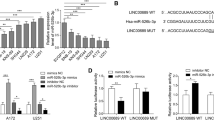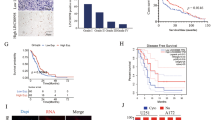Abstract
Background
Glioma is a common brain malignancy, and the purpose of this study is to investigate the function of LINC02308 in glioma.
Methods
The differentially expressed lncRNAs were screened by microarray. The expression of LINC02308 in glioma tissues and cells was evaluated. The interaction among LINC02308, miR-30e-3p, and TM4SF1 was determined. Cell proliferation and apoptosis were evaluated. The expression of mTOR/AKT-signaling and apoptosis-related markers was detected by Western blot. A xenograft tumor mouse model was constructed to investigate the roles of LINC02308.
Results
LINC02308 was significantly overexpressed in glioma, and a high LINC02308 level was correlated with a poor prognosis. LINC02308 silencing markedly inhibited proliferation and reduced apoptosis of glioma cells and also suppressed tumor growth in the xenograft tumor mouse model. Finally, we demonstrated that LINC02308 played its oncogenic role through binding to miR-30e-3p so as to relieve miR-30e-3p-induced suppression of TM4SF1.
Conclusions
LINC02308 promoted glioma tumorigenesis as a sponge of miR-30e-3p to upregulate TM4SF1 and activate AKT/mTOR pathway.

Hypothesis diagram illustrates the function and mechanism of LINC02308 in glioma. A schematic representation of the functional mechanism of LINC02308 in glioma.






Similar content being viewed by others
Data availability
The data that support the findings of this study are available on request from the corresponding author Yang Cao, Department of Clinical Laboratory, The First Hospital of Jilin University, No. 3302 Jilin Road, Erdao District, Changchun City, Jilin Province, 130021, P. R. China. E-mail: YangCaoChangchun@163.com. Some data are not publicly available due to the possibility of compromising the privacy of research participants.
References
Chen X, et al. MiR-9 promotes tumorigenesis and angiogenesis and is activated by MYC and OCT4 in human glioma. J Exp Clin Cancer Res : CR. 2019a;38:99. https://doi.org/10.1186/s13046-019-1078-2.
Chen Y, Bao C, Zhang X, Lin X, Huang H, Wang Z. Long non-coding RNA HCG11 modulates glioma progression through cooperating with miR-496/CPEB3 axis. Cell Prolif. 2019b;52:e12615. https://doi.org/10.1111/cpr.12615.
Chinnaiyan P, et al. The metabolomic signature of malignant glioma reflects accelerated anabolic metabolism. Cancer Res. 2012;72:5878–88. https://doi.org/10.1158/0008-5472.can-12-1572-t.
Cui B, Li B, Liu Q, Cui Y. lncRNA CCAT1 promotes glioma tumorigenesis by sponging miR-181b. J Cell Biochem. 2017;118:4548–57. https://doi.org/10.1002/jcb.26116.
Fan X, et al. Local anesthetics impair the growth and self-renewal of glioblastoma stem cells by inhibiting ZDHHC15-mediated GP130 palmitoylation. Stem Cell Res Ther. 2021;12:107. https://doi.org/10.1186/s13287-021-02175-2.
Fan YZ, Huang H, Wang S, Tan GJ, Zhang QZ. Effect of lncRNA MALAT1 on rats with myocardial infarction through regulating ERK/MAPK signaling pathway. Eur Rev Med Pharmacol Sci. 2019;23:9041–9. https://doi.org/10.26355/eurrev_201910_19306.
Goldar S, Khaniani MS, Derakhshan SM, Baradaran B. Molecular mechanisms of apoptosis and roles in cancer development and treatment. Asian Pac J Cancer Prev : APJCP. 2015;16:2129–44. https://doi.org/10.7314/apjcp.2015.16.6.2129.
Gramantieri L, et al. MiR-30e-3p influences tumor phenotype through MDM2/TP53 axis and predicts sorafenib resistance in hepatocellular carcinoma. Cancer Res. 2020;80:1720–34. https://doi.org/10.1158/0008-5472.can-19-0472.
Gusyatiner O, Hegi ME. Glioma epigenetics: from subclassification to novel treatment options. Semin Cancer Biol. 2018;51:50–8. https://doi.org/10.1016/j.semcancer.2017.11.010.
Jiang C, et al. Upregulation of CASC2 sensitized glioma to temozolomide cytotoxicity through autophagy inhibition by sponging miR-193a-5p and regulating mTOR expression. Biomed Pharmacother = Biomedecine & pharmacotherapie. 2018;97:844–50. https://doi.org/10.1016/j.biopha.2017.10.146.
Laplante M, Sabatini DM. mTOR signaling in growth control and disease. Cell. 2012;149:274–93. https://doi.org/10.1016/j.cell.2012.03.017.
Lin S, Gregory RI. MicroRNA biogenesis pathways in cancer. Nat Rev Cancer. 2015;15:321–33. https://doi.org/10.1038/nrc3932.
Liu H, Li G, Zhao W, Hu Y. Inhibition of miR-92a may protect endothelial cells after acute myocardial infarction in rats: role of KLF2/4. Med Sci Monit : international medical journal of experimental and clinical research. 2016;22:2451–62. https://doi.org/10.12659/msm.897266.
Liu L, Li Y, Pan B, Zhang T, Wei D, Zhu Y, et al. Nr5a2 promotes tumor growth and metastasis of gastric cancer AGS cells by Wnt/beta-catenin signaling. OncoTargets Ther. 2019a;12:2891–902. https://doi.org/10.2147/ott.s201228.
Liu X, Zhu Q, Guo Y, Xiao Z, Hu L, Xu Q. LncRNA LINC00689 promotes the growth, metastasis and glycolysis of glioma cells by targeting miR-338-3p/PKM2 axis. Biomed Pharmacother = Biomedecine & pharmacotherapie. 2019b;117:109069. https://doi.org/10.1016/j.biopha.2019.109069.
Liu Y, Xu Y, Ding L, Yu L, Zhang B, Wei D. LncRNA MEG3 suppressed the progression of ovarian cancer via sponging miR-30e-3p and regulating LAMA4 expression. Cancer Cell Int. 2020;20:181. https://doi.org/10.1186/s12935-020-01259-y.
Luan X, Wang Y. LncRNA XLOC_006390 facilitates cervical cancer tumorigenesis and metastasis as a ceRNA against miR-331-3p and miR-338-3p. J Gynecol Oncol. 2018;29:e95. https://doi.org/10.3802/jgo.2018.29.e95.
Lubelski D, Abdullah KG, Weil RJ, Marko NF. Bevacizumab for radiation necrosis following treatment of high grade glioma: a systematic review of the literature. J Neuro-Oncol. 2013;115:317–22. https://doi.org/10.1007/s11060-013-1233-0.
Nan Y, et al. MiRNA-451 inhibits glioma cell proliferation and invasion through the mTOR/HIF-1α/VEGF signaling pathway by targeting CAB39. Human Gene Therapy Clin Dev. 2018;29:156–66. https://doi.org/10.1089/humc.2018.133.
Ni W, et al. A novel lncRNA uc.134 represses hepatocellular carcinoma progression by inhibiting CUL4A-mediated ubiquitination of LATS1. J Hematol Oncol. 2017;10:91. https://doi.org/10.1186/s13045-017-0449-4.
Ostrom QT, et al. American Brain Tumor Association adolescent and young adult primary brain and central nervous system tumors diagnosed in the United States in 2008-2012. Neuro-Oncology. 2016;18(Suppl 1):i1–i50. https://doi.org/10.1093/neuonc/nov297.
Ouyang Q, Xu L, Cui H, Xu M, Yi L. MicroRNAs and cell cycle of malignant glioma. Int J Neurosci. 2016;126:1–9. https://doi.org/10.3109/00207454.2015.1017881.
Patterson JD, Henson JC, Breese RO, Bielamowicz KJ, Rodriguez A. CAR T cell therapy for pediatric brain tumors. Front Oncol. 2020;10:1582. https://doi.org/10.3389/fonc.2020.01582.
Quinn JJ, Chang HY. Unique features of long non-coding RNA biogenesis and function. Nat Rev Genet. 2016;17:47–62. https://doi.org/10.1038/nrg.2015.10.
Shi J, Zhang Y, Qin B, Wang Y, Zhu X. Long non-coding RNA LINC00174 promotes glycolysis and tumor progression by regulating miR-152-3p/SLC2A1 axis in glioma. J Exp Clin Cancer Res : CR. 2019;38:395. https://doi.org/10.1186/s13046-019-1390-x.
Siegel RL, Miller KD, Jemal A. Cancer statistics. CA Cancer J Clin. 2018;68:7–30. https://doi.org/10.3322/caac.21442.
Sun Y, Xu Y, Xu J, Lu D, Wang J. Role of TM4SF1 in regulating breast cancer cell migration and apoptosis through PI3K/AKT/mTOR pathway. Int J Clin Exp Pathol. 2015;8:9081–8.
Tang F, et al. LncRNA-ATB promotes TGF-β-induced glioma cells invasion through NF-κB and P38/MAPK pathway. J Cell Physiol. 2019;234:23302–14. https://doi.org/10.1002/jcp.28898.
Terstappen GC, Meyer AH, Bell RD, Zhang W. Strategies for delivering therapeutics across the blood-brain barrier. Nat Rev Drug Discov. 2021. https://doi.org/10.1038/s41573-021-00139-y.
Wang D, Zhu C, Zhang Y, Zheng Y, Ma F, Su L, et al. MicroRNA-30e-3p inhibits cell invasion and migration in clear cell renal cell carcinoma by targeting. Snail Oncol Lett. 2017;13:2053–8. https://doi.org/10.3892/ol.2017.5690.
Wang L, Wu J, Lu J, Ma R, Sun D, Tang J. Regulation of the cell cycle and PI3K/Akt/mTOR signaling pathway by tanshinone I in human breast cancer cell lines. Mol Med Rep. 2015a;11:931–9. https://doi.org/10.3892/mmr.2014.2819.
Wang P, Bao W, Zhang G, Cui H, Shi G. Transmembrane-4-L-six-family-1, a potential predictor for poor prognosis, overexpressed in human glioma. Neuroreport. 2015b;26:455–61. https://doi.org/10.1097/wnr.0000000000000370.
Weller M, Wick W, Aldape K, Brada M, Berger M, Pfister SM, et al. Glioma. Nat Rev Disease Prim. 2015;1:15017. https://doi.org/10.1038/nrdp.2015.17.
Wong RS. Apoptosis in cancer: from pathogenesis to treatment. J Exp Clin Cancer Res : CR. 2011;30:87. https://doi.org/10.1186/1756-9966-30-87.
Wu D, et al. MAD2-p31(comet) axis deficiency reduces cell proliferation, migration and sensitivity of microtubule-interfering agents in glioma. Biochem Biophys Res Commun. 2018;498:157–63. https://doi.org/10.1016/j.bbrc.2018.02.011.
Xiao L, et al. Long noncoding RNA uc.173 promotes renewal of the intestinal mucosa by inducing degradation of microRNA 195. Gastroenterology. 2018;154:599–611. https://doi.org/10.1053/j.gastro.2017.10.009.
Xue J, et al. miR-182-5p Induced by STAT3 activation promotes glioma tumorigenesis. Cancer Res. 2016;76:4293–304. https://doi.org/10.1158/0008-5472.can-15-3073.
Ye L, et al. Transmembrane-4 L-six family member-1 (TM4SF1) promotes non-small cell lung cancer proliferation, invasion and chemo-resistance through regulating the DDR1/Akt/ERK-mTOR axis. Respir Res. 2019;20:106. https://doi.org/10.1186/s12931-019-1071-5.
Zhang Y, Jin T, Shen H, Yan J, Guan M, Jin X. Identification of long non-coding RNA expression profiles and co-expression genes in thyroid carcinoma based on The Cancer Genome Atlas (TCGA) database. Med Sci Monit : international medical journal of experimental and clinical research. 2019;25:9752–69. https://doi.org/10.12659/msm.917845.
Zheng J, Liu X, Wang P, Xue Y, Ma J, Qu C, et al. CRNDE promotes malignant progression of glioma by attenuating miR-384/PIWIL4/STAT3 axis. Mol Ther : the journal of the American Society of Gene Therapy. 2016;24:1199–215. https://doi.org/10.1038/mt.2016.71.
Zhou K, Zhang C, Yao H, Zhang X, Zhou Y, Che Y, et al. Knockdown of long non-coding RNA NEAT1 inhibits glioma cell migration and invasion via modulation of SOX2 targeted by miR-132. Mol Cancer. 2018;17:105. https://doi.org/10.1186/s12943-018-0849-2.
Code availability
Not applicable.
Funding
This work was supported by the Science and Technology Project of Health Commission of Sichuan Province (Grant No. 18PJ430) and the Field of Scientific Research Develop Project of North Sichuan Medical College in 2017 (Grant No. CBY17-A-YB39).
Author information
Authors and Affiliations
Contributions
Xianfeng Gao and Xiaoya Wang supervised the whole study, performed data analysis, and prepared the manuscript. Huaiqiang He and Yang Cao collected and analyzed data and prepared the manuscript.
Corresponding author
Ethics declarations
Ethical approval and consent to participate
Informed consent was obtained from all individual participants included in the study. All procedures were approved by the Human and Animal Ethics Committee of Clinical Laboratory, the First Hospital of Jilin University.
Consent for publication
Not applicable.
Conflict of interest
All other authors have no conflicts of interest. We declare that we do not have any commercial or associative interest that represents a conflict of interest in connection with the work submitted.
Additional information
Publisher’s note
Springer Nature remains neutral with regard to jurisdictional claims in published maps and institutional affiliations.
Supplementary Information
ESM 1
LINC02308 was upregulated in glioma tissues and predicted a poor prognosis in TCGA dataset. (A) The volcano plots of differentially expressed mRNAs in GSE103227 (fold change >1.0 and P < 0.05). The red points represent dysregulated lncRNAs, and blue points represent dysregulated mRNAs. (B) The expression of LINC02308 in glioma with different grades including glioblastoma (GBM) and low-grade glioma (LGG) in TCGA dataset was analyzed by GEPIA. (C) Survival analysis of glioma patients (overall survival and disease free survival) with high and low LINC02308 expression was performed by Kaplan-Meier curve in TCGA dataset. * P < 0.05 (PNG 671 kb)
Rights and permissions
About this article
Cite this article
Gao, X., Wang, X., He, H. et al. LINC02308 promotes the progression of glioma through activating mTOR/AKT-signaling pathway by targeting miR-30e-3p/TM4SF1 axis. Cell Biol Toxicol 38, 223–236 (2022). https://doi.org/10.1007/s10565-021-09604-1
Received:
Accepted:
Published:
Issue Date:
DOI: https://doi.org/10.1007/s10565-021-09604-1




